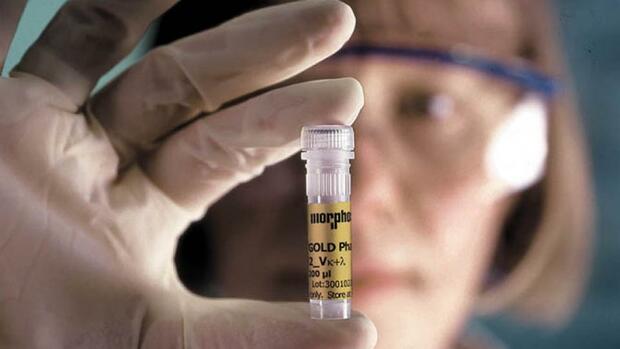Frankfurt After a long dry spell, the Munich-based biotech company Morphosys has regained some investor confidence with a number of positive reports. At a conference in the USA, the company published favorable long-term data for its already approved blood cancer drug Monjuvi.
A few days earlier, Morphosys had already announced that a study with the development project Pelabresib, another promising cancer drug, is progressing faster than expected.
Since then, the Morphosys share has gained a good third on the stock exchange. However, the company’s market capitalization of around 650 million euros is still far behind valuations that sometimes amounted to more than 3 billion euros.
Monjuvi has been approved since 2020 for the treatment of diffuse large B-cell lymphoma (DLBCL), a cancer characterized by the uncontrolled multiplication of certain white blood cells.
The drug may be used in patients for whom standard therapy is no longer effective and for whom stem cell transplantation is not an option. It is distributed by Morphosys together with the US company Incyte, but has so far been commercially disappointing due to intense competition. Sales last year were only 85 million euros.
Impact rate still high after five years
Against this background, it is very important for Morphosys to present further positive results with Monjuvi. The data presented at the Congress of the American Association for Cancer Research (AACR) showed that the drug still had a relatively high rate of effectiveness five years after the start of treatment.
41
percent
of treated patients remained cancer-free five years after starting treatment with the blood cancer drug Monjuvi.
In a good 41 percent of the treated patients, the cancer had then completely disappeared, in another 16 percent partially. Even after five years of treatment, the data was almost as good as in the original evaluation from 2019. At that time, complete remissions were observed in 43 percent of patients.
“The sustained response and consistent tolerability profile are encouraging and support the potential of Monjuvi treatment to cure the disease in appropriate patients,” said Tim Demuth, Morphosys Chief Research Officer. Senior physician Johannes Düll, who led the study with the drug at the Medical Clinic and Polyclinic of the University Clinic in Würzburg, made a similar statement.
In a large study, Morphosys is currently also testing Monjuvi in first-line therapy, i.e. for the primary treatment of DLBCL, and hopes to significantly improve its market position in the therapy field over the next few years with further positive data. The main competitor is the pharmaceutical giant Roche with its cancer drug Polivy, which has already been approved for the first-line therapy of DLBCL. In addition, novel cell therapies are being used more and more frequently for this type of cancer.
Approvals are not a guarantee of success
Morphosys started in the 1990s as a specialist in the development of antibodies and as a technology partner for large pharmaceutical companies and was one of the pioneers in the German biotech industry at the time. In recent years, however, Morphosys has completely shifted its strategy to developing its own drugs, taking the most important expansion step in 2020 with the acquisition of the US biotech company Constellation.
>> Also read: Biotech companies have to face a dry spell when it comes to financing
Next to Biontech, Morphosys is one of the German biotech companies that have made the furthest progress in drug development. After all, one of the company’s products is already on the market, and two others are in advanced clinical tests. However, the development of the Munich company also shows that successful approvals alone do not guarantee success in the pharmaceutical business. Rather, the quality of the clinical results is decisive – especially in comparison with established therapies and competing new developments.
This also applies to the second important hope, the drug candidate pelabresib, which Morphosys acquired with Constellation and is now testing against myelofibrosis in a larger phase 3 study with around 400 participants. This is a relatively rare and rather slowly progressing blood cancer disease in which blood-forming cells in the bone marrow are overgrown by connective tissue. This in turn impairs blood formation and leads to painful enlargement of the spleen and liver.
Morphosys recently announced that patient recruitment for the study had progressed faster than originally planned. The company now intends to present key data before the end of the year. “This saves us important time and, if successful, we can bring the product to the patient more quickly,” says company boss Jean Paul Kress.
All in all, Morphosys hopes to complete development six months ahead of schedule. If Pelabresib actually delivers positive data, approval in 2025 seems possible. Kress emphasizes that physicians and patients are very interested in the active substance, which is evidenced by the fact that patients were quickly included in the study.
Treatment options for myelofibrosis have so far been limited. Morphosys therefore hopes to establish a new therapy standard with the active ingredient. According to Morphosys, the drug reduces the excessive activity of certain genes, which are considered to be partly responsible for the disease. The company’s researchers therefore believe that the active ingredient, unlike the preparations available to date, addresses the causes of the disease.
The number of patients is estimated at about 35,000 each in the US and in Europe. From the point of view of analysts, it is therefore a market with sales potential of several billion dollars. However, intense competition is also emerging in this area. The main competitor is the US group Abbvie with its drug candidate Navitoclax, for which results from a phase 3 study relevant for approval are expected as early as the middle of the year.
One is aware of the competition, but convinced of the potential of Pelabresib, says Morphosys boss Kress. “We believe that pelabresib could improve the current standard of care in the initial treatment of myelofibrosis.”
More: More sales than the rest of the industry combined: Biontech is setting itself apart more and more
